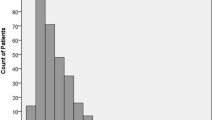Abstract
Background
Incisional hernia repair is one of the most common general surgery operations being performed today. With the advancement of laparoscopy since the 1990s, we have seen vast improvements in faster return to normal activity, shorter hospital stays and less post-operative narcotic use, to name a few.
Objective
The key aims of this review were to measure the impact of minimally invasive surgery versus open surgery on health care utilization, cost, and work place absenteeism in the patients undergoing inpatient incisional/ventral hernia (IVH) repair.
Methods
We analyzed data from the Truven Health Analytics MarketScan® Commercial Claims and Encounters Database. Total of 2557 patients were included in the analysis.
Results
Of the patient that underwent IVH surgery, 24.5% (n = 626) were done utilizing minimally invasive surgical (MIS) techniques and 75.5% (n = 1931) were done open. Ninety-day post-surgery outcomes were significantly lower in the MIS group compared to the open group for total payment ($19,288.97 vs. $21,708.12), inpatient length of stay (3.12 vs. 4.24 days), number of outpatient visit (5.48 vs. 7.35), and estimated days off (11.3 vs. 14.64), respectively. At 365 days post-surgery, the total payment ($27,497.96 vs. $30,157.29), inpatient length of stay (3.70 vs. 5.04 days), outpatient visits (19.75 vs. 23.42), and estimated days off (35.71 vs. 41.58) were significantly lower for MIS group versus the open group, respectively.
Conclusion
When surgical repair of IVH is performed, there is a clear advantage in the MIS approach versus the open approach in regard to cost, length of stay, number of outpatient visits, and estimated days off.



Similar content being viewed by others
References
Wechter ME, Pearlman MD, Hartmann KE (2005) Reclosure of the disrupted laparotomy wound: a systematic review. Obstet Gynecol 106(2):376–383
Fink C, Baumann P, Wente MN, Knebel P, Bruckner T, Ulrich A, Werner J, Buchler MW, Diener MK (2014) Incisional hernia rate 3 years after midline laparotomy. Br J Surg 101(2):51–54
Poulose BK, Shelton J, Phillips S, Moore D, Nealon W, Penson D, Beck W, Holzman MD (2012) Epidemiology and cost of ventral hernia repair: making the case for hernia research. Hernia 16:179–183
LeBlanc KA, Booth WV (1993) Laparoscopic repair of incisional abdominal hernias using expanded polytetrafluoroethylene: preliminary findings. Surg Laparosc Endosc 3:39–41
Holman MD, Purut CM, Reintgen S, Eubanks S, Pappas TN (1997) Laparoscopic ventral and incisional hernioplasty. Surg Endosc 11:32–35
Kaoutzanis C, Leichtle SW, Mouawad NJ, Welch KB, Lampman RM, Cleary RK (2013) Postoperative surgical site infections after ventral/incisional hernia repair: a comparison of open and laparoscopic outcomes. Surg Endosc. doi:10.1007/s00464-012-2743-0
Goodney PP, Birkmeyer CM, Birkmeyer JD (2002) Short-term outcomes of laparoscopic and open ventral hernia repair. Arch Surg 137:1161–1165
Sajid MS, Bokhari SA, Mallick AS, Cheek E, Baig MK (2009) Laparoscopic versus open repair of incisional/ventral hernia: a meta-analysis. Am J Surg 197:64–72
Mason RJ, Moazzez A, Sohn HJ, Berne TV, Katkhouda N (2011) Laparoscopic versus open anterior abdominal wall hernia repair: 30-day morbidity and mortality using the ACS-NSQIP database. Ann Surg 254:641–652
Sauerland S, Walgenbach M, Habermalz B, Seiler CM, Miserez M (2011) Laparoscopic versus open surgical techniques for ventral or incisional hernia repair. Cochrane Database Syst Rev. doi:10.1002/14651858.CD007781.pub2
Krpata DM, Schmotzer BJ, Flocke S, Jin J, Blatnik JA, Ermlich B, Novitsky YW, Rosen MJ (2012) Design and initial implementation of HerQLes: a hernia-related quality-of-life survey to assess abdominal wall function. J Am Coll Surg 215:635–642
Kouhia ST, Heiskanen JT, Huttunen R, Ahtola HI, Kiviniemi VV, Hakala T (2010) Long-term follow-up of a randomized clinical trial of open versus laparoscopic appendectomy. Br J Surg 97(9):1395–1400
Nguyen NT, Ho HS, Palmer LS et al (2000) A comparison study of laparoscopic versus open gastric bypass for morbid obesity. J Am Coll Surg 191:149–155
Qiu S, Doyon LM, Divino CM (2014) The safety of laparoscopic versus open ventral hernia repair in 23,327 morbidly obese patients. J Surg Res 186(2):538–538
Holzer A, Jirecek ST, Illievich UM, Huber J, Wenzl RJ (2006) Laparoscopic versus open myomectomy: a double-blind study to evaluate postoperative pain. Anesth Analg 102(5):1480–1484
Neumayer L, Giobbie-Hurder A, Jonasson O, Fitzgibbons R, Dunlop D, Gibbs J, Reda D, Henderson W (2004) Open mesh versus laparoscopic mesh repair of inguinal hernia. N Engl J Med 350(18):1819–1827
Funk LM, Perry KA, Narula VK, Mikami DJ, Melvin WS (2013) Current national practice patterns for inpatient management of ventral abdominal wall hernia in the United States. Surg Endosc 27(11):4112
Author information
Authors and Affiliations
Ethics declarations
Disclosures
Dean Mikami is a consultant for Medtronic, W.L. Gore and BD. W. Scott Melvin is a consultant for Stryker. Kenric Murayama and Michael Murayama have no conflict of interest.
Rights and permissions
About this article
Cite this article
Mikami, D.J., Melvin, W.S., Murayama, M.J. et al. Impact of minimally invasive surgery on healthcare utilization, cost, and workplace absenteeism in patients with Incisional/Ventral Hernia (IVH). Surg Endosc 31, 4412–4418 (2017). https://doi.org/10.1007/s00464-017-5488-y
Received:
Accepted:
Published:
Issue Date:
DOI: https://doi.org/10.1007/s00464-017-5488-y




